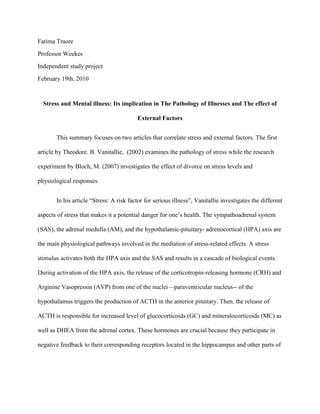
Stress And External Factors
- 1. Fatima Traore<br />Professor Weekes <br />Independent study project<br />February 19th, 2010<br />Stress and Mental illness: Its implication in The Pathology of Illnesses and The effect of External Factors<br />This summary focuses on two articles that correlate stress and external factors. The first article by Theodore. B. Vanitallie, (2002) examines the pathology of stress while the research experiment by Bloch, M. (2007) investigates the effect of divorce on stress levels and physiological responses.<br />In his article “Stress: A risk factor for serious illness”, Vanitallie investigates the different aspects of stress that makes it a potential danger for one’s health. The sympathoadrenal system (SAS), the adrenal medulla (AM), and the hypothalamic-pituitary- adrenocortical (HPA) axis are the main physiological pathways involved in the mediation of stress-related effects. A stress stimulus activates both the HPA axis and the SAS and results in a cascade of biological events. During activation of the HPA axis, the release of the corticotropin-releasing hormone (CRH) and Arginine Vasopressin (AVP) from one of the nuclei—paraventricular nucleus-- of the hypothalamus triggers the production of ACTH in the anterior pituitary. Then, the release of ACTH is responsible for increased level of glucocorticoids (GC) and mineralocorticoids (MC) as well as DHEA from the adrenal cortex. These hormones are crucial because they participate in negative feedback to their corresponding receptors located in the hippocampus and other parts of the brain. As of the SAS, its activation results in increased-level of Norepinephrine and neuropeptide-Y. <br />Physiological responses to stress due to excessive activation of the HPA axis and SAS are of significance because they decrease BDNF-levels that is important for neurogenesis in the hippocampus and neurons survival and LH/Testosterone. One of the major risk is atrophy of the hippocampus that is linked with a decline in memory and cognition in case of prolonged and severe stress. To that we must qualify that not all types of stress are bad for the body. Acute stress can be beneficial for quick responses to a potential threat or enhanced cognition while chronic stress or overactivation of stress-mediated systems weakens the immune system and increases the body’s vulnerability to illnesses. The best current model used to study the pathology of stress is post-traumatic stress disorder (PTSD). Subjects affected with PTSD display a large range of physiological and behavioral responses that help understanding the mechanisms underlying stress-induced illnesses.<br />In her article “ Long-term effects of early parental loss (EPL) due to divorce on the HPA axis”, Miki Black and colleagues investigated the effect of divorce on the endocrine system in health adults (defined as psychopathology-free). The rationale behind this study is that early traumatism due to premature separation of parents can be a factor in stress-induced vulnerability to illnesses later on in the life of affected individuals. They hypothesized that if EPL due to divorce will result in lower or normal basal cortisol levels, but an increased response of the HPA axis to CRH. They also hypothesize that the level of stress at home prior to the divorce and the quality of parental bonding with the child will moderate the effect of divorce on the HPA axis response to CRH stimulation. The cut-off was age 10 for the 22 participants in the experimental group of affected individuals with a control group equal number of participants. The authors used the CRH stimulation test to detect changes in HPA sensitivity. Subjects were matched by many categories including gender, social status, age, weight, and religion. The results showed consistently lower cortisol levels for both control and experimental groups although they did not reach statistical significance. Moreover, the negative result for the activation of the HPA axis following CRH test did not support their hypothesis. In sum, the results provide partial evidence for the effect of EPL-induced stress on the HPA axis of affected subjects, and or somewhat inconclusive with high p-values of .60 and .68 for CRH and Cortisol tests respectively. <br />I think that their approach was interesting and the study was well controlled for internal factors such as gender and age. However, they sample size may have been too small or the cut-off age inaccurate. Also, previous work has demonstrated that men tend to me less susceptible to stress than women. Therefore, the inclusion of men in the study may have prevented the results to reach statistical significance. Finally, the level stress assessed was perhaps not severe enough to induce long-term changes on the HPA axis or could have caused a reversal effect described as higher resilience. <br />References<br />Bloch, M., Peleg, I., Koren, D., Aner, H., & Klein, E. (2007). Long-term effects of early parental loss due to divorce on the HPA axis. Hormones and Behavior, 51(4), 516-523.<br />Vanitallie, T. B. (2002). Stress: A risk factor for serious illness. Metabolism: Clinical and Experimental, 51(6 Suppl 1), 40-45.<br />